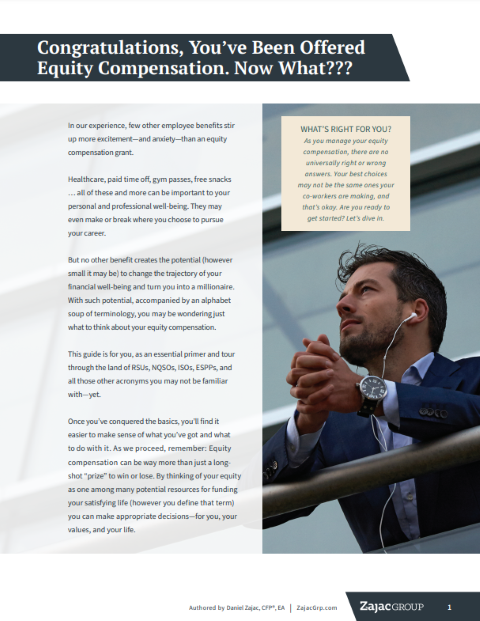If you own company stock inside your 401(k) plan, you may want to know about net unrealized appreciation. Net unrealized appreciation, or NUA, is a financial planning technique that may allow you to obtain preferential tax treatment on a portion of your 401(k) assets.
Most people with a 401(k) plan understand that they will pay ordinary income rates on money withdrawn (assuming they contributed pre-tax, non-Roth 401(k) money). For the most part, this assumption is true.
Using net unrealized appreciation, however, you may be able to transfer a portion of your 401(k) assets to receive long-term capital gains treatment. Long-term capital gains tax rates tend to run lower than ordinary income tax rates; they can be as low as 0% or as high as 20%. They’re often somewhere in the middle, at 15%.
The more the value of your 401(k) is tied up in company stock, and the greater the spread between the cost basis (what the shares of the stock cost when they were purchased in your 401(k) plan), the more likely it is that using NUA will be a valuable planning technique.
A Simple Net Unrealized Appreciation Example
Let’s assume that you are a 65-year-old retiree with $1,500,000 in an employer-sponsored 401(k) plan. Let’s further assume $500,000 of the total account balance is invested in company stock, and that stock has a cost basis (what you paid for it) of $75,000.
In this scenario, you have several options to consider. A few common options include keeping the 401(k) plan assets where they are, rolling the assets to an IRA, taking a distribution of some plan assets, or taking a distribution of all the plan assets.
You will want to check your plan document to see exactly what rules pertain to your plan and what your options may be.
To simplify our net unrealized appreciation example, let’s assume that you only have two options for your 401(k) plan:
- Keep the money in the 401(k) and/or roll the account over to a tax-deferred IRA
- Use net unrealized appreciation
Option 1: Keep Funds in the Plan or Roll the 401(k) into an IRA (and Do Not Use NUA)
If you choose option 1 and do not use net unrealized appreciation, you will keep all your assets inside a 401(k) or an IRA. Assuming all the assets are pre-tax assets, all future account distributions will be taxed as ordinary income. In our example, this means all 1,500,000, as well as future growth, will be subject to ordinary income when distributed.
Option 2: Use Net Unrealized Appreciation
If you have company stock inside your 401(k) plan, you may want to consider net unrealized appreciation so you can take advantage of long-term capital gains rates.
Here is a general idea of how it works:
- You elect to take a distribution of company stock inside your 401(k) plan “in-kind.” This means you will transfer company stock inside your 401(k) to a non-IRA investment account. When this transaction occurs, you are creating a taxable event to report on your tax return for that calendar year. The amount that is taxable is the cost basis of the company stock.
- If you have a capital gain in the company stock (the difference between the cost basis and the fair market value), it is immediately eligible for preferential long-term capital gains treatment.
- If you are distributing the entire 401(k) account balance during this same process, the remaining balance can likely be rolled over into an IRA in a non-taxable event. If you do not roll this over and take it as a distribution, you may be subject to ordinary income on the distribution.
The Potential Value of Net Unrealized Appreciation ‒ A Tax Comparison
A simple tax calculation comparing tax implications for a scenario with net unrealized appreciation and another scenario without allows us to illustrate the potential value of this technique.
Let’s assume that the current fair market value of your company stock is $500,000 and the cost basis of the stock is $75,000. In order to run a calculation to show the two different outcomes, we need to make some simple assumptions as they pertain to tax.
We’ll assume the following:
- Ordinary Income Tax Rates: 33%
- Long-Term Capital Gains Tax Rate: 15%
Finally, assume that in each scenario, the full $500,000 is distributed from the 401(k) and converted to cash as quickly as possible.
Using this hypothetical, it is easy for us to illustrate the outcome, as detailed in the chart below:
| Fair Market Value | Taxed as Ordinary Income | Taxed as Capital Gains | Ordinary Income tax (33%) | Capital Gains Tax (15%) | Total Tax | |
| No NUA | $500,000 | $500,000 | $0 | $165,000 | $0 | $165,000 |
| NUA | $500,000 | $75,000 | $425,000 | $24,750 | $63,750 | $88,500 |
In the “No NUA” scenario, the entire $500,000 is distributed and taxed at 33%. The tax due is $165,000.
In the “NUA” scenario, assuming that the stock is sold immediately after it is distributed and taxed at long-term capital gains rates, the tax liability is $88,500.
In this simple example, net unrealized appreciation saves over $80,000 in taxes.
When Net Unrealized Appreciation May Make Sense
It is easy to make net unrealized appreciation look attractive using a hypothetical illustration as detailed above, but it may not make sense for every single situation. Here are some specific times when you should consider this strategy:
- If you have highly appreciated stock in your 401(k) plan
If you have company stock that has gone up substantially in value, net unrealized appreciation may be something to consider. The larger the spread between the cost basis and the current market value, the stronger the argument for net unrealized appreciation. This is because the larger the capital gain, the larger the opportunity to pay capital gains tax in lieu of ordinary income tax. Paying 15% in lieu of paying 33% may lead to major tax savings.
- Large Spread in Tax Brackets
Tax brackets change based on levels of income for both ordinary income tax and capital gains tax. The larger the spread between the two, the greater the opportunity will be to utilize preferential long-term capital gains treatment.
- When You Are Seeking to Lower Your Required Minimum Distributions
Diversification* is a common term that is used when it comes to investing. In short, it simply means don’t have all your eggs in one basket.
As diversification pertains to retirement income planning, it may also mean tax diversification, or having different types of assets in retirement. This means taxable assets, tax-deferred assets, and tax-free assets. Net unrealized appreciation can be a strategy that efficiently transitions tax-deferred assets and makes them taxable. Since the portion of your assets that is subject to NUA are no longer in an IRA or 401(k), the account value will not be included in the RMD calculation. This transaction has the net effect of lowering RMDs in retirement.
Should You Consider Leveraging Net Unrealized Appreciation?
If you think net unrealized appreciation is something you would like to consider, start by checking your employer 401(k) plan document to see what rules may pertain to your plan.
It might also make sense to speak with an expert who can help you sort through the details so that you can determine how big the spread between the cost basis and fair market value is and how NUA fits into your overall financial plan.
Implemented appropriately, net unrealized appreciation may lower your overall net tax liability, therefore leaving you with more cash in your pocket.










Wow, I had never heard of this. Fascinating. Thanks for the great article!
Happy to provide some new information! Thanks for reading
Wow. That is a major difference. I thought it would be 15% of 425 at least.